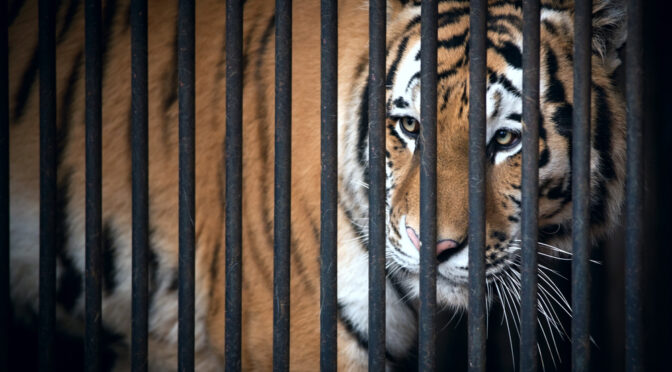A heartbreaking tragedy happened the other day, and I’m sure most of you have already heard about it. A 17 year old male gorilla named Harambe was shot and killed after a 4 year old boy fell into his enclosure. It has sparked an international debate about everything from how parents should watch their children, to whether or not zoos should even exist in the first place. This article is more about the latter, although I do want to discuss what happened to Harambe as well.
Just so you know, I have worked with or around animals for my entire life. Everything from farm animals to rare and exotic animals including big game. I have volunteered at farms, zoos, sanctuaries, private reserves, veterinary clinics, a couple animal rehabilitation centers and even a marine mammal stranding center. I have spent time around several monkeys and apes, including gorillas.
Because of my experiences, I have noticed a few important aspects of the situation that are being overlooked during this worldwide debate, and I would like to raise to attention to a few of them.
Obviously what happened the other day is a tragedy, but it is also unchangeable. All we can do is try to prevent it from happening again. That being said, this was the first incident of its kind at Cincinnati Zoo.
The staff was in just as much a panic as the screaming bystanders were. The gorilla was dragging the child by his foot through 6 inches of water, with numerous people screaming and yelling down at them. Harambe was obviously confused and didn’t understand what was going on, while the boy was crying out in fear. If you saw the video, you must admit that the situation was indeed terrifying to watch.
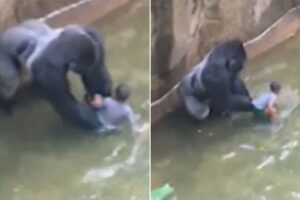
Here is the video from the other day, if you want to see it for yourself.
Generally, gorillas are very shy and reserved towards people. They will attack only if they are surprised or threatened or if a person behaves in the wrong way, such as making aggressive movements like beating your hands on your chest.
This was The Cincinnati Zoo’s first incident, (they have been open since 1978) but it’s not the first time this has happened worldwide. There are several other cases where children have fallen into gorilla enclosures before. Most notably back in 1996, when a 3 year old boy fell into a zoos enclosure and was ‘saved’ by a female gorilla that picked him up while he was unconscious and carried him to a door so staff could help him. The media praised the gorilla for saving the little boy.
Here is a video from that incident too.
Harambe was 17 years old and knew his keepers and enclosure very well. He was clearly being rough with the boy, by dragging him around by his foot as Harambe may have done with his own offspring, but it was also very clear that he was not threatened by the child, nor was he intentionally trying to hurt him. The boy was with him for several minutes without any further injuries. (He sustained a few scratches and a concussion, but most witnesses believe that actually happened when the boy first fell) Had Harambe considered him to be a threat, the boy would have been killed instantly.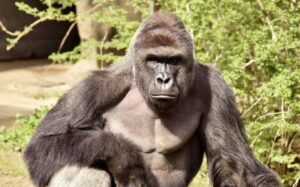
That being said, I still believe the zoo staff made the only decision they could under the unfortunate circumstances. Tranquilizers are not instantaneous. They take several minutes to kick in, and that’s only if the animal was calm and relaxed when the dart hit them. A dart, no matter how strong, will not take down an animal that is already upset and has adrenaline pumping through its veins.
Had they hit the gorilla with a dart, there is no way it would have worked in time. Not only that, it absolutely would have angered the gorilla, thus putting the child in even more harms way. The mother is partially to blame, as is the zoo for not having a 100% child-proof enclosure. Actions should be taken by the zoo to ensure this doesn’t happen again. Hopefully something positive can come from this tragedy.
And now, here comes the biggest part of the debate. Whether or not zoos should still exist in our modern society. Of course, if you’re an animal lover, the first thought that usually comes to mind is ”These animals should not be in captivity! They should be in the wild where they belong!” and I absolutely agree. They should be living in their native habitat. But can they even so do anymore?
Take rhinos for example. I’ve been living in South Africa for two years now. One of the world issues that I focus on most is anti-poaching. While I living in the South African bush, just outside Kruger National Park, a rhino was shot and cut to pieces with an axe, not even 500 feet from where I was sleeping that night. Not one of us ever heard a thing, which made the incident all the more terrifying.
Poachers are killing rhinos, elephants, pangolins, gorillas and many other endangered animals so quickly that they are going extinct at an astounding rate. (Did you know, there are only an estimated 800 silverback gorillas left in the world??) Everything we’ve been trying isn’t working in the long term sense. Painting and poisoning horns and tusks did absolutely nothing but increase the demand. Arming squads of rangers with specially trained tracking dogs and lightweight planes and helicopters has definitely reduced the number of casualties, but it’s certainly not stopping the poachers completely. Poachers have a far larger budget at their disposal.
Their tech and weapons are usually far better than what the rangers have. Not to mention the fact that these poachers were raised in the bush, so they are usually even better trackers than many of the rangers are.
The situation is so bad, our rangers can’t even stop these poachers from occasionally going into fully guarded sanctuaries, private reserves and rehabilitation centers and butchering our elephants and rhinos during the middle of the night and taking their horns and tusks. It costs an absolute fortune to protect even the smallest herd of rhinos in a private reserve.
That’s because the only way to do so is by guarding them 24/7 with a squad of fully armed mercenaries, most of the time with anti-poaching dogs. In most circumstances, the owners of large game farms can only afford to guard their animals with the money they make from the tourism industry or from trophy hunts done on their property.. But obviously that only helps a small handful of privately owned rhinos; not the rhinos still living in the wild.
 Now I must ask you.. Have you ever heard of the Knysna Elephant? How about the Cape Lion or the Quagga? I’ll be thoroughly impressed if you have, because they’re completely extinct due to overhunting and habitat loss.
Now I must ask you.. Have you ever heard of the Knysna Elephant? How about the Cape Lion or the Quagga? I’ll be thoroughly impressed if you have, because they’re completely extinct due to overhunting and habitat loss.
Other subspecies of rhinos, elephants and many other animals are quickly dying off. Rhinos have been on this planet for millions of years, and researchers now say they will be completely extinct in the wild within the next 10 years. Several subspecies of rhino, like the Western Black Rhino and the Northern White Rhino, have already gone extinct recently.
Something must be done, and if it’s not done quickly, then we will lose all our rhinos, our elephants, our tigers, our gorillas, and countless other endangered animals. The ONLY METHOD we know of that is 100% effective against poachers, is to remove the endangered animals from harm’s way completely. The biggest problem with that is the cost.
To remove even just 1 wild rhino from Kruger National Park and have them taken to a private reserve not far away, costs the equivalent of about $45,000. That is just the cost of removal and transport. That is not what it costs to fly them even further away, feed them, house them, guard them, take care of their medical needs, etc. The only way we can afford to do all those things, is via donations. Either by raising awareness during fundraisers, or by the tourism or trophy hunting industry.
On that note, there is another aspect about zoos that I’d like to mention. When I was 15 and volunteering at the local Zoo in my hometown of New York, I was appalled by how small some of the enclosures were back then, while others seemed so large.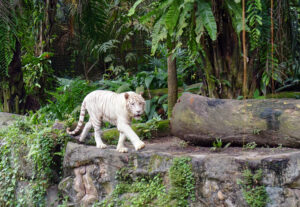
It upset me, so one day when I had the opportunity to sit down with the zoo’s assistant director, I asked her why some animals had such large enclosures while others had such small ones. She explained about the zoo’s budget, and how it all comes from small donations and entrance fees.
The entrance fees usually keep the lights on and covers the cost of the staff, the food and the medical needs for all the animals, etc.
Donations are how they raise more money for building larger enclosures. Those ‘adopt an animal’ programs do make a difference for many animals, but not all of them. Everyone wants to sponsor an elephant, a lion or a clouded leopard, while the poor fruit bats, naked mole rats and other ‘less-appreciated’ animals almost always get ignored by the public.
You see the point I’m getting at? WE, the public, are responsible for the size of our animals enclosures. Awareness and fundraisers can get any animal a better living environment. We just need to inspire people to care more about their animals.
Please keep in mind that most zoos are not like they once were. Zoo animals used to be kept in barred cages that were barely big enough for them to stand in. Now, most zoos do everything they can do provide their animals with a large, safe, and stimulating environment for the animals to raise their families in. Every zookeeper I have ever known has shown nothing but 100% devotion to their animals.
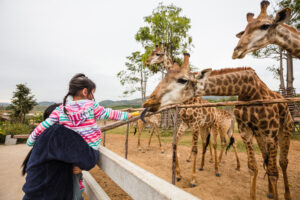 They certainly didn’t become a zookeeper for their measly salary, and they absolutely didn’t become a zookeeper because they wanted to watch their favorite animals suffer in confined quarters. Keepers do the absolute best they can with the resources they have available to them.
They certainly didn’t become a zookeeper for their measly salary, and they absolutely didn’t become a zookeeper because they wanted to watch their favorite animals suffer in confined quarters. Keepers do the absolute best they can with the resources they have available to them.
Please know, I’m not saying all zoos are like this, because they are not.. But I am saying that the situation is not as black and white as many people seem to think it is. There are many more good zoos out there than there are bad ones.
I guess the point I’m trying to make is this… We’re losing our flora and fauna left and right. Scientists estimate we are losing between 150-200 species EVERY SINGLE DAY. We humans are overhunting and overfishing. We are ignoring the poaching and trophy hunting epidemic.
We are making excuses about our pollution and our overuse of the earth’s resources, and we are stealing or destroying the land our animals need to survive.. Because of this, animals being confined to enclosures is merely a symptom of an issue that has been getting steadily worse for over the past 150 years.
If we got rid of our zoos, where would we put our most endangered animals? How could we inspire our children to have a respect and appreciation for these animals if they know nothing about them and have never even seen one before? Boycotting zoos and refusing to donate to them will only cause more animals to suffer, and we will lose more of our precious species even faster than we already are.
Just think about it, and feel free to continue this debate in our comments section. Thank you!
– By Lara Starr

